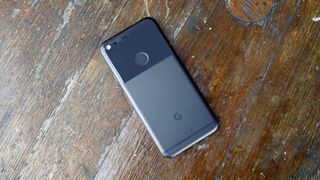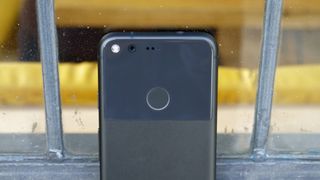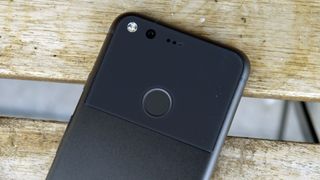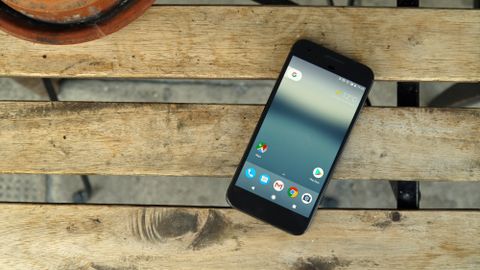Why you can trust TechRadar
Battery life
- A day’s use with moderate to light usage
- Regularly required a mid-evening top-up
The Google Pixel battery life is nothing special. If you’re careful with your usage you’ll get a full day out of the phone, but we found that given moderate use a mid-evening charge was required to ensure we made it to bedtime without a flat battery.
The Pixel squeezes in a non-removable 2,770mAh power pack. That's bigger than the battery in the iPhone 7 (1,960mAh), but smaller than those in the Samsung Galaxy S7 (3,000mAh) and HTC 10 (3,000mAh).
That size difference tallies with general performance, as both the Samsung and HTC put in better battery showings than the Pixel, with the new iPhone in a similarly dicey state come the evening.
Watch below to see how the Google Pixel compares to the Pixel XL in terms of battery when browsing websites, watching videos and gaming.
It’s not all bad news though, as the new Pixel boasts fast charging, giving you up to seven hours of usage from a 15-minute blast. That’s certainly handy when you’re about to leave the office and want your phone to survive the Clash Royale onslaught you have planned for your journey home.
You’ll need to make sure you have the charger that comes in the box on you though, as a standard USB-C cable and plug block won’t get you the same rapid recharge action.

We put the fast charging to the test, plugging in when we were down to 13% at around 6pm. Fifteen minutes later the Pixel was up to 27%.
It seems unlikely that an additional 14% of juice would get you anywhere close to seven hours of use – you’d have to turn off Wi-Fi, mobile data, Bluetooth and NFC, while turning the brightness way down and restricting your usage to basic applications.
If you are desperate to get the most juice from your top-up, turn the Pixel off and it’ll charge faster. While it was charging the Pixel quoted us around an hour and 40 minutes to fill the battery to 100%.

The phone achieved a surprising result in our battery video test though. We played a 90-minute full HD video on the Pixel, with screen brightness whacked up to max and the phone connected to Wi-Fi and syncing multiple accounts in the background.
When the 90 minutes were up the Pixel had lost just 15%, which is a very respectable result. It’s a result which also puts its bigger brother, the Pixel XL, to shame – although while that phone has a bigger battery it also has a larger, higher-resolution display.
That puts the Pixel on a level with the Galaxy S7, Galaxy S7 Edge and Moto Z Force – which is certainly esteemed company. It’s just a shame it doesn’t perform as well as those phones throughout a whole day.
The Pixel just about gets away with its battery life, and if you keep your gaming and music streaming to short blasts you can expect to see almost a full day from a single charge. If you’re a heavier user though, you will need to keep a charger with you.
Camera
- A very, very good snapper, but it doesn’t wow
- Lens Blur is inconsistent, while low-light shots are okay
The 12.3MP rear camera on the Google Pixel is another big talking point for the search giant, which holds the title of the highest-rated camera ever on DxO – an industry standard for camera and lens image quality measurements and ratings. That’s quite the claim to fame.
The Pixel scored 89 overall in the DxO tests, putting it above all its flagship competition. The excellent Galaxy S7 Edge managed 88, as did the HTC 10 and Sony Xperia X Performance, while iPhone 7 came in a little lower at 86.
That’s all well and good, and it gives Google a strong marketing line, although we've found that DxO ratings don't always translate into excellent camera performance day-to-day.

Things start well for the Pixel, with the straightforward camera app making it easy to snap a quick picture. Shutter speeds are fast in good light, and the autofocus generally does a good job of getting your subject in focus – we found that a fast-moving kitten, however, did appear blurred in some shots.
The Pixel doesn’t bombard you with options in the camera app. There are toggles for HDR+, the timer, grid lines, flash and basic white balance settings (cloudy, sunny, fluorescent and tungsten) in the top corner, while a slide-out menu on the left provides a few more tools.
Slow Motion capture, Panorama and Photo Sphere modes are joined by Lens Blur, which is designed to create the blurred bokeh background effect you get with DSLR and compact system cameras, and the top-end camera on the iPhone 7 Plus – although with its small single lens the Pixel has to do this digitally, with mixed results.
Dip into the settings and you’ll find an equally humble offering, with resolution selectors for the front and rear cameras pretty much the only point of note.
You can adjust the brightness of your shots though – just place a finger on the screen and slide it up or down.

The HDR+ (High Dynamic Range Plus) mode is set to 'auto' by default, and we found that most of the time that was the best setting. HDR+ brightens up areas in shadow, reduces blurring and helps out in low-light scenarios.
We found it worked best at dawn and dusk, when the light isn’t at its most plentiful but total darkness isn’t hampering the camera. Snapping a shot with HDR+ working its magic at these times of day resulted in images looking brighter, but still well detailed.
Moving into the night and the Pixel struggled a little, with noticeable blurring and noise in our snaps. It’s certainly not as impressive as the Galaxy S7 and S7 Edge in this scenario.
The Lens Blur mode isn’t anything new, and we saw the likes of HTC, Sony and Samsung battle it out a few years ago with this background defocus effect. On the Pixel the digital enhancement works okay, but it’s not a patch on a DSLR or a dual-lens smartphone setup like that on the HTC One M8 or iPhone 7 Plus.

We found the Pixel struggled to separate foreground and background elements well enough, resulting in blur bleed between subjects.
Day-to-day shots are very, very good – don’t get us wrong –- but the Pixel’s camera doesn’t tend to wow you. You’re unlikely to be disappointed with the shots you take on this phone, but they don’t have the same impact or color palette as those from some rival flagships.
Round the front, the 8MP selfie camera is serviceable, and can be accessed by twisting the Pixel twice in your hand – repeating the motion returns to you to rear camera, and it makes one-handed operation easier.
Pictures are bright and clear, although we did find that our selfies lacked clarity at times. There’s no beauty mode to speak of, but if anything we’re thankful for that, as those can often be overbearing.
Camera samples gallery














John joined TechRadar over a decade ago as Staff Writer for Phones, and over the years has built up a vast knowledge of the tech industry. He's interviewed CEOs from some of the world's biggest tech firms, visited their HQs and has appeared on live TV and radio, including Sky News, BBC News, BBC World News, Al Jazeera, LBC and BBC Radio 4. Originally specializing in phones, tablets and wearables, John is now TechRadar's resident automotive expert, reviewing the latest and greatest EVs and PHEVs on the market. John also looks after the day-to-day running of the site.
